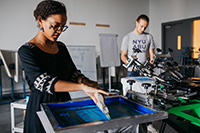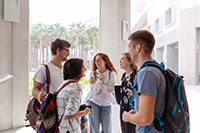The presence of a world-class neurolinguistic laboratory based in Abu Dhabi has an important significance for the field of linguistics; it means evidence-based research in a field currently dominated by English and other Western languages will increasingly be more inclusive of different, and often underrepresented, languages.
For NYU Abu Dhabi's Neuroscience of Language Lab, which uses a sophisticated magnetoencephalography (MEG) machine to study the brain activity of subjects in response to specifically designed experiments, contributing to the body of knowledge in the field of linguistics means not only furthering existing theory, but also understanding and studying this theory in a more globalized context.
The team of professors, postdoctoral associates, research assistants, and visiting NYU New York Ph.D. students working in the lab are concurrently investigating a number of research areas. One significant research endeavor is focused on understanding the way the brain stores and accesses individual words and how this process is affected by different properties such as frequency and context of use (for example, if a word functions as a noun or a verb).
In a study of complex and compound words that can be separated into parts (such as verbs followed by the gerund suffix –ing), the team has designed experiments to see if brain activity indicates that individual units are stored and then combined, or if these multi-part words are stored in the brain as a single unit.
In other research areas, the opportunity to review brain responses among subjects who are bilingual in English and Arabic has presented unique insights into the similarities and differences of how the brain comprehends and processes these two languages, and also how two languages co-exist in the brain. Differences in the structures of the languages themselves, like the way Arabic intertwines components to create complex words while English uses suffixes and prefixes with a base word, create interesting questions on whether these different structures require different underlying neurological processes.
The study of bilingualism itself is another important area of investigation. Postdoctoral Associate Stephen Politzer-Ahles explained: "How are the two languages represented in the brain? Are the English and Arabic words in the same area and are they competing with each other, or do you have English over here and Arabic over there?" The value of studying different languages in developing linguistic theory can also play an important role in offering a more complete and comprehensive data set for the interpretation of research findings.
"We could do all this research in English and conclude 'this is the part of the brain that does this aspect of language,'" Politzer-Ahles said. "But if it turns out that really, the place of a word in that sentence [in English] is highly predictable, it might be that rather than being a 'language' part of the brain, the response relates to a 'prediction' part of the brain. This is why it's valuable to look at different languages."


